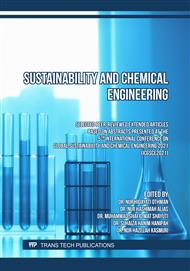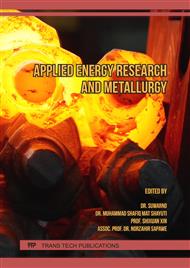[1]
J.P. Clark, Emulsions: When oil and water do mix, Food Technology 67(8) (2013), Information on https://www.ift.org.
Google Scholar
[2]
M.M. Abdulredha, S.A. Murtada, Overview on petroleum emulsion, formation, influence and demulsification treatment techniques, Arabian Journal of Chemistry 13(1) (2018) 3403-3428.
DOI: 10.1016/j.arabjc.2018.11.014
Google Scholar
[3]
L.L. Schramm, Emulsions: Fundamentals and Applications in the Petroleum Industry, Advances in Chemistry Series, 231, American Chemical Society, Washington, DC, (1992).
Google Scholar
[4]
J. Sjöblom, O. Urdahl, K.C.N. Borve, L. Mingyuan, J.O. Saeten, A.A. Christy, T. Gu, Stabilisation and destabilisation of water-in-crude oil emulsions from the Norwegian continental shelf 7: Corelations with model systems, Advances in Colloids and Interface Science 41 (1992) 241-271.
DOI: 10.1016/0001-8686(92)80014-o
Google Scholar
[5]
J. Sjöblom, R. Lindberg, S.E. Friberg, Microemulsions – phase equilibria, characterizations, structures, applications and chemical reactions, Advances in Colloids and Interface Science 65 (1996) 125 – 287.
DOI: 10.1016/0001-8686(96)00293-x
Google Scholar
[6]
B. Mortada, D Daaou, Water pH and surfactant addition effects on the stability of an Algerian crude oil emulsion, Journal of Saudi Chemical Society 16(3) (2012) 333-337.
DOI: 10.1016/j.jscs.2011.05.015
Google Scholar
[7]
E.S. Sellman, G.W. Sams, S.P.K. Mandewalkar, Improved dehydration and desalting of mature crude oil fields. Paper presented at the SPE Middle East Oil and Gas Show and Conference 10-13 March 2013, Manama, Bahrain (2013).
DOI: 10.2118/164289-ms
Google Scholar
[8]
T.F. Tadros, Surfactants, Academic Press, London, (1984).
Google Scholar
[9]
D.M. Lloyd, I.T. Norton, F. Spyropoulos, Process optimisation of rotating membrane emulsification through the study of surfactant dispersion, Journal of Food Engineering 166 (2015) 316-324.
DOI: 10.1016/j.jfoodeng.2015.06.028
Google Scholar
[10]
N.I. Politovaa, S, Tcholakova, S. Tsibtanska, N.D. Denkov, K. Muelheims. I, Coalescence stability of water-in-oil drops: Effect of drop size and surfactant concentration, Colloids and Surfaces A. Physicochemical and Engineering Aspects 531 (2017) 32-39.
DOI: 10.1016/j.colsurfa.2017.07.085
Google Scholar
[11]
S. Akbari, A.H. Nour, S.S. Jamari, F. Fayaz, Rheology and stability mechanism of water-in-crude oil emulsions stabilized by Span 83, ARPN Journal of Engineering and Applied Science 11(4) (2016) 2230-2235.
Google Scholar
[12]
M.A. Rasha, A.H. Nour, A.Z. Sulaiman, Kinetic stability and rheology of water-in-crude oil emulsion stabilized by Cocamide at different water volume fraction, International Journal of Chemical Engineering and Applications 5(2) (2014) 204-209.
DOI: 10.7763/ijcea.2014.v5.379
Google Scholar
[13]
X. Yang, J. Wang, H. Song, W. Zou, Thermal properties and solubility of methyl-α-D-glucopyranoside in methanol at different temperatures, Fluid Phase Equilibria 409(15) (2016) 417-424.
DOI: 10.1016/j.fluid.2015.10.047
Google Scholar
[14]
O.S. Amodu, S.K. Ntwampe, T.V. Ojumu, Emulsification of hydrocarbon by biosurfactant: Exclusive use of agrowaste, BioResourses 9(2) (2014) 3508-3525.
DOI: 10.15376/biores.9.2.3508-3525
Google Scholar
[15]
A.I.A. Mohamed, A.S. Sultan, I.A. Hussein, G.A. Al-Muntasheri, Influence of surfactant structure on the stability of water-in-oil emulsions under high-temperature high-salinity conditions, Journal of Chemistry Volume 2017 (2017) ID 5471376.
DOI: 10.1155/2017/5471376
Google Scholar
[16]
C. Zheng, Z. Li, J. Su, R. Zhang, C. Liu, M. Zhao, Characterization and emulsifying property of a novel bioemulsifier by Aeribacillus pallidus YM-1, Journal of Applied Microbiology 113(1) (2012) 44-51.
DOI: 10.1111/j.1365-2672.2012.05313.x
Google Scholar
[17]
M, Sifour, M.H. Al-Jilawi, G.M. Aziz, Emulsification properties of biosurfactant produced from Pseudomonas aeruginosa RB 28, Pakistan Journal of Biological Sciences 10(8) (2007) 1331-1335.
DOI: 10.3923/pjbs.2007.1331.1335
Google Scholar
[18]
F.R. Mello, C. De Bernard, C.O. Dias, L. Gonzaga, E.R. Amante, R. Fett, L.M.B. Candido, Antioxidant properties, quantification and stability of betalains from pitaya (Hylocereus undatus) Peel, Food Technology 45(2) (2015) 323–328.
DOI: 10.1590/0103-8478cr20140548
Google Scholar
[19]
E. Susanti, S. Budi Utomo,Y. Syukri, T. Redjeki, Phytochemical screening and analysis polyphenolic antioxidant activity of methanolic extract of white dragon fruit (Hylocereus undatus), Indones. J. Pharm. 23 (1) (2012) 60-64.
Google Scholar
[20]
A.M. Som, N. Ahmat, H.A. Abdul Hamid, N.M. Azizuddin, A comparative study on foliage and peels of Hylocereus undatus (white dragon fruit) regarding their antioxidant activity and phenolic content, Heliyon 5(2) (2019) e01244.
DOI: 10.1016/j.heliyon.2019.e01244
Google Scholar
[21]
J. Idris, A.M. Som, M. Musa, K.H. Ku Hamid, R. Husen, M.N. Muhd Rodhi, Dragon fruit foliage plant-based coagulant for treatment of concentrated latex effluent: Comparison of treatment with ferric sulfate, Journal of Chemistry 2013 (2013) Article ID 230860.
DOI: 10.1155/2013/230860
Google Scholar
[22]
A.M. Som, A.F.A. Wahab, Performance study of dragon fruit foliage as a plant-based coagulant for treatment of palm oil mill effluent from three-phase decanter, BioResources 13(2) (2018) 4290-4300.
DOI: 10.15376/biores.13.2.4290-4300
Google Scholar
[23]
D.J. McClements, Food Emulsions: Principles, Practices, and Techniques, third ed., CRC press, Boca Raton, (2015).
Google Scholar
[24]
C. Owens, K. Griffin, H. Khouryieh, K. Williams, Creaming and oxidative stability of fish oil-in-water emulsions stabilised by whey protein-xanthan-locust bean complexes: Impact on pH, Food Chemistry 239 (2018) 314-322.
DOI: 10.1016/j.foodchem.2017.06.096
Google Scholar
[25]
N.M. Mollakhalili, M.A. Mohammadifar, K.H. Abdolmaleki, Effect of dispersed phase volume fraction on physical stability of oil-in-water emulsion in the presence of gum tragacanth, Journal of Food Quality and Hazard Control 1 (4) (2014) 102-107.
Google Scholar
[26]
K. Fontenot, F.J. Schrock, Sensitivities of droplet size and stability in monomeric emulsions, Industrial and Engineering Chemistry Research 32 (2) (1993) 373-385.
DOI: 10.1021/ie00014a014
Google Scholar
[27]
V.P. Dimri, R.P. Srivastava, N. Vedanti, Reservoir geophysics: Some basic concepts, in: J. Kasahara, V, Korneev, M.S. Zhdanov, Handbook of Geophysical Exploration: Seismic Exploration, Elsevier B.V., Amsterdam, 2012, pp.89-118.
DOI: 10.1016/b978-0-08-045158-9.00005-1
Google Scholar
[28]
B.P. Hollebone, Oil Physical Properties, in: M. Fingas (Ed.) Oil Spill Science and Technology, Wiley, New Jersey, 2014, pp.38-50.
DOI: 10.1002/9781118989982.ch2
Google Scholar
[29]
Q. Chang, Colloid and Interface Chemistry for Water Quality Control, first ed., Elsevier Academic Press, London, (2016).
Google Scholar
[30]
A. Mohammed, S.I. Okeye, J. Salisu, Effect of dispersed phase viscosity on stability of emulsion produced by a rotor stator homogenizer. International Journal of Sciences: Basic and Applied Research 25 (2) (2016) 256-267.
Google Scholar
[31]
L. Zheng, C. Cao, Z. Chen, L. Cao, Q. Huang, B. Song, Evaluation of emulsion stability by monitoring the interaction between droplets, Food Science and Technology 132 (2020) 109804.
DOI: 10.1016/j.lwt.2020.109804
Google Scholar
[32]
A. Zungur, M. Koc, F.K. Ertekin, Physical properties of olive oil in water model emulsion: Effect of aqueous and oil phase concentration and homogenization types, Academic Food Journal/ Akademik GIDA 13 (1) (2015).
Google Scholar
[33]
T. Ralla, H. Salminen, K. Braun, M. Edelmann, C. Dawid, T. Hofmann, J. Weiss, Investigations into the structure-function relationship of the naturally-derived surfactant Glycyrrhizin: Emulsion stability, Food Biophysics 15 (2020) 288-296.
DOI: 10.1007/s11483-020-09624-0
Google Scholar



